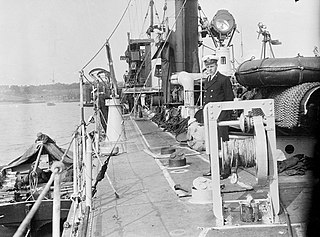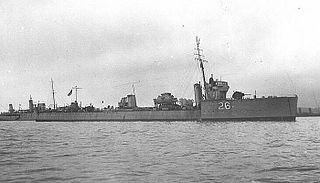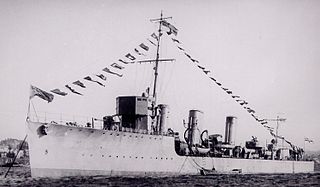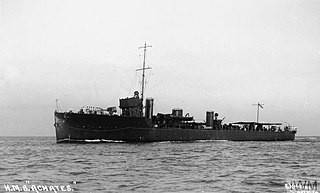
HMS Ambuscade was an Acasta-class destroyer of the Royal Navy and was launched in 1913. She served throughout the First World War, forming part of the Grand Fleet and taking part at the Battle of Jutland, serving in the Dover Patrol and spending the latter part of the war as a convoy escort. She was sold for scrapping in 1921.

HMS Laforey was the lead ship of her class of destroyer built for the Royal Navy. Launched a year before the First World War began, she was attached to the Dover Patrol. Laforey saw action in several engagements with German torpedo boats, including the Battle off Noordhinder Bank and the action of 17 March 1917. Laforey was sunk in 1917 by a British mine after escorting several freighters to France. She was named for Francis Laforey, captain of HMS Spartiate at the Battle of Trafalgar in 1805.
HMS Ophelia was an Admiralty M-class destroyer built for the Royal Navy during the First World War, entering service in 1916. The ship served at the Battle of Jutland on 31 May/1 June 1916, and sank a German submarine in 1918. She was sold for scrap in 1921.

HMS Strongbow was an M-class destroyer built for the British Royal Navy during the First World War. The ship was launched in September 1916 and entered service in November that year. Stongbow was sunk on 17 October 1917 by the German light cruisers SMS Bremse and Brummer in the North Sea, when escorting a convoy of merchant ships from Norway.

HMS Porpoise was an Acasta-class destroyer of the Royal Navy, which was built by Thornycroft between 1912 and 1914. Porpoise served through the First World War, taking part at the Battle of Jutland in 1916, where she was damaged. In 1920, she was sold to the Brazilian Navy serving under the name Alexandrino de Alencar and was renamed Maranhão in 1927. Maranhão remained in service when Brazil entered the Second World War, being used for patrol and convoy duties. She was disposed of in 1945.

HMS Cockatrice was an Acasta-class destroyer of the British Royal Navy. She was built by Hawthorn Leslie and Company, launching in 1912 and served throughout the First World War. She was sold for scrap in 1921.

HMS Partridge was a Royal Navy Admiralty M-class destroyer constructed and then operational in the First World War, later being sunk by enemy action in 1917. The destroyer was the sixth Royal Navy vessel to carry the name HMS Partridge.

HMS Rob Roy was a Royal Navy R-class destroyer constructed and then operational in the First World War. The ship served in the Grand Fleet as part of the Fifteenth Destroyer Flotilla.
HMS Christopher was an Acasta-class destroyer of the British Royal Navy. She was built by Hawthorn Leslie in 1911–1912. She served throughout the First World War, forming part of the Grand Fleet until 1916 and taking part in the Battle of Jutland. Later in the war she served in the English Channel to protect merchant shipping against attacks by German U-boats. Christopher was sold for scrap in May 1921.

HMS Sorceress was an R-class destroyer which served with the Royal Navy during World War I. Launched on 29 August 1916, the vessel operated as part of the Grand Fleet until it was disbanded in 1919. In 1917, the ship took part in action against German Sixth Destroyer Flotilla and was one of those credited with bounty for the German auxiliary cruiser Konprinz Willhelm. The destroyer was sold to be broken up on 29 April 1927.

HMS Rapid was a destroyer of the M class which served with the Royal Navy. Launched by Thornycroft on 15 July 1916 as the first of six similar ships, the destroyer served as part of the Grand Fleet during World War I. The design was used as the basis for the subsequent five ships of the R-class also built by the yard. Rapid served in escort and patrol roles, principally providing defence from submarines as part of the Grand Fleet until it was disbanded at the end of the War. After the end of hostilities, the vessel served in minor roles, including briefly as part of the Admiralty Compass Department, but was sold to be scrapped on 20 April 1927.

HMS Ready was a destroyer of the M class which served with the Royal Navy. Launched by Thornycroft on 14 October 1916, the vessel was the one of two similar ships ordered as part of the Fifth War Construction Programme. They differed from the remainder of the M class in having more powerful engines. On commissioning, Ready operated within the Grand Fleet until it was disbanded at the end of the First World War. The vessel was credited with helping to sink a German Q-ship in 1917. After the war, the destroyer was initially transferred to HMNB Portsmouth, but was retired and sold to be broken up on 13 July 1926 after almost a decade of service as part of a preparation for a fleet of new destroyers.

HMS Achates was an Acasta -class destroyer of the British Royal Navy. She was built by the Scottish shipbuilder John Brown and was built between 1912 and 1913. Like all Acasta-class destroyers, Achates was armed with three 4-inch (102 mm) guns and two torpedo tubes, with a specified speed of 29 knots.

HMS Sarpedon was an R-class destroyer which served with the Royal Navy. he R class were a development of the preceding M-class, but differed in having geared turbines and other design changes. Launched in June 1916, the vessel escorted convoys that sailed between Scotland and Scandinavia in the First World War. After the war, the ship was allocated to local defence at Nore. However, in 1923, the Navy decided to retire many of the older vessels and Sarpedon was retired and was sold to be broken up on 23 June 1926.
HMS Saumarez was a Parker-class flotilla leader of the British Royal Navy. She was built by Cammell Laird during the First World War, being launched on 14 October 1916 and completing on 21 December that year. Saumarez served with the Grand Fleet for the rest of the war, which she survived. The ship was sold for scrap in January 1931.

HMS Restless was an R-class destroyer which served with the Royal Navy during World War I. Launched on 12 August 1916, the ship operated as part of the Grand Fleet, operating as part of a destroyer flotilla protecting convoys in the North Sea. After the War, the destroyer served in the Mediterranean Sea and was sold to be broken up on 23 November 1936.

HMS Rowena was an R-class destroyer which served with the Royal Navy during World War I. Launched on 1 July 1916, the ship operated as part of the Grand Fleet as part of a destroyer flotilla hunting for German vessels that were attacking convoys in the North Sea. Although there were many reported sightings, no submarines were sunk. After the conflict, the vessel was transferred to the Navy’s establishment at Portland to help in the development of anti-submarine warfare, which ultimately helped in the Battle of the Atlantic. Rowena did not, however, see the fruit of this labour. After twenty years of service, the destroyer was retired and sold to be broken up on 27 January 1937.

HMS Rocket was an R-class destroyer which served with the Royal Navy during World War I. Launched on 2 July 1916 after being stuck on the slipway since 30 June, the ship joined the Grand Fleet, operating as part of a destroyer flotilla undertaking anti-submarine operations in the North Sea. Although the ship did not successfully engage any German submarines, there was an incident with the Royal Navy boat K7 on 16 June 1917, although that attack was aborted after the erstwhile target was identified as a friendly vessel. After the War, the destroyer served with the anti-submarine and torpedo schools at Portsmouth, and briefly during the Chanak Crisis of 1922, before being sold to be broken up on 16 December 1926.

HMS Peyton was a Admiralty M-class destroyer which served with the Royal Navy during the First World War. The M class were an improvement on the preceding L class, capable of higher speed. Launched on 2 May 1916, the vessel served in anti-submarine and escort duties based at Cobh in Ireland. The destroyer attacked the German submarine SM UB-23 and rescued crews from friendly merchant ships that had been sunk. After the end of the war, Peyton was placed in reserve and subsequently broken up on 9 May 1921.

HMS Pellew was a Admiralty M-class destroyer which served with the Royal Navy during the First World War. The M class were an improvement on the preceding L class, capable of higher speed. Launched on 18 April 1916, the vessel served with the Grand Fleet escorting convoys. The vessel was part of an unsuccessful attempt by the navy to trap the German submarines that had taken such a heavy toll on merchant shipping in December 1917. The action involved an eight-ship convoy consisting of four merchant vessels escorted by two armed trawlers and the sister ships Pellew and Partridge. Instead of submarines, four German destroyers attacked, sinking all but one member of the convoy and disappearing before the light cruisers which were to be the spring in the trap could arrive. Pellew, the sole survivor, took refuge in a Norwegian fjord. After the armistice that ended the war, the destroyer was placed in reserve and subsequently sold to be broken up on 9 May 1921.















